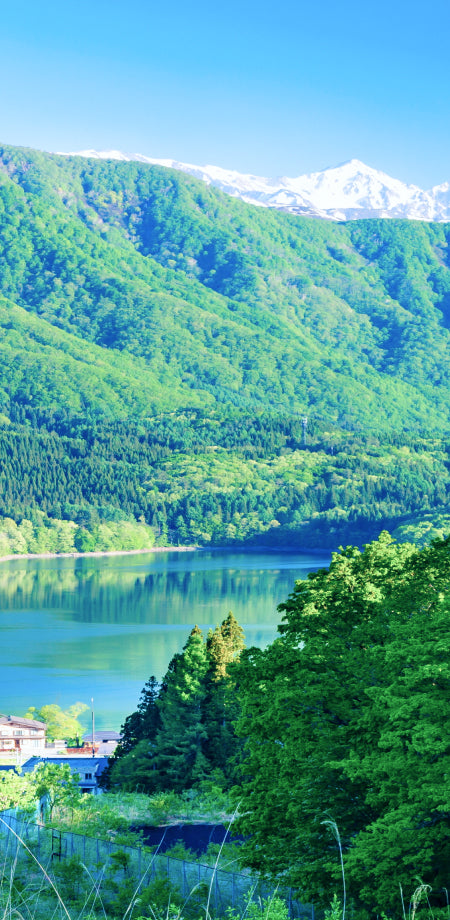Mushroom production volume in Japan! I want to eat summer, delicious in the summer of Nagano prefecture

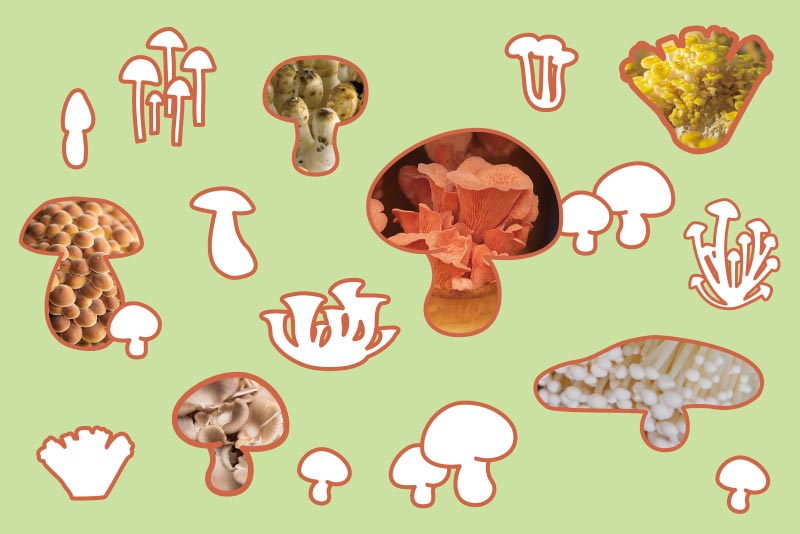
Mushrooms are said to have more than 60,000 types around the world. Did you know that there are 4,000 to 5,000 species in Japan, of which about 300 species are edible? It is a mushroom that is often thought to be an autumn ingredient, but in nature, various mushrooms grow throughout the year. Mushrooms rich in vitamin B1, which supports the intestinal environment, and vitamin B1, which supports energy from carbohydrates, is actually an ingredient that summer body is looking for. In Nagano Prefecture, which boasts the highest production volume in Japan, we were particular about the growth environment and visited the production site where unique initiatives are being carried out, approaching this secret and charm.
A rich mountain mushroom grown in the wilderness
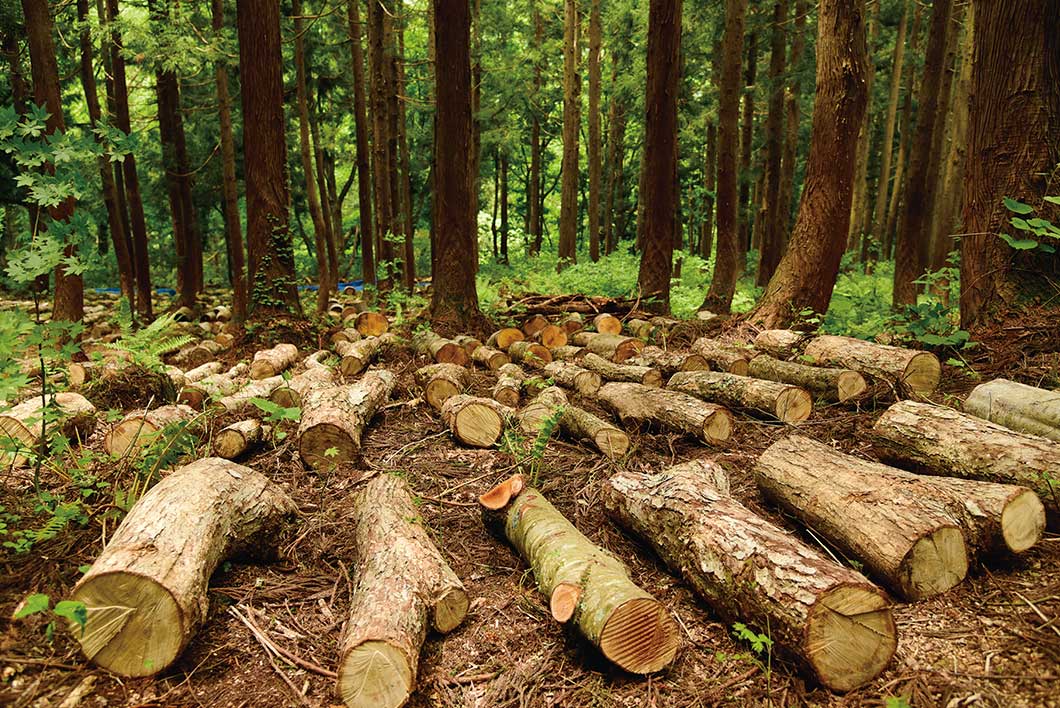
Marunaka Rodge(Nozawa Onsen Village)
As you finally go on a mountain path that can be passed by one car, you will see an area where multiple logs are lined up on the mountain skin. The log is a big mushroom that can be seen from a distance. "Marunaka Rodge" is working on log cultivation in the mountains of Nozawa Onsen Village. About 20 years ago, it was renewed from a guest house to an hands -on lodge, and the guests themselves to harvest mushrooms and wild vegetables by the owner, and enjoy the mountains, so many fans come to know. It is "Kinoko inn" to know.
"The mushrooms are completely different in flavor and umami. The clear four seasons of Nozawa Onsen Village nurture delicious mushrooms."
The owner, Akihiko Kadowaki, talks like this. Mushrooms grown in an environment that are endlessly close to natural is surprisingly large, and some grow into size such as maitake, such as maitake mushrooms.
Kadowaki -san, from the cultivation of the ran of the ran, the mushrooms, the spring shiitake mushrooms in mid -May, the summer tatami mushrooms, the autumn mushrooms, the autumn mushrooms, the nameko, the autumn shiitake, and the finally called the "Winter Mushroom Room". About 10 kinds of mushrooms are grown through. It takes about two years from driving this bacterium into the raw wood to the harvest, but the compatibility between the bacteria and the log is important, and Mr. Kadowaki looks at the tree and chooses bacteria.
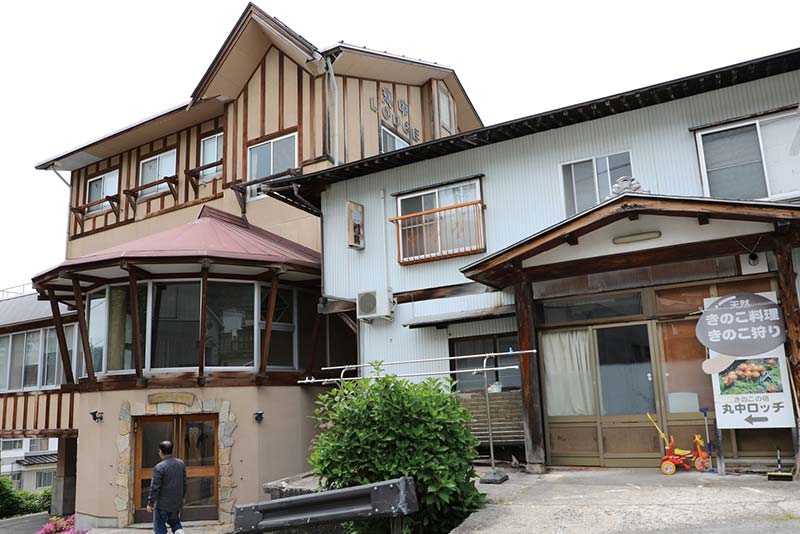
In addition, you will visit the mountains every day during the harvest so that you can harvest the most delicious eating time to determine the timing. Kadowaki says, "It's the best time to eat when it changes from dark color to light brown," said Maitake mushrooms, which have a strong gray -brown image. The experience of cultivating over the years with failures fosters the finest mushrooms.
"Mushrooms have the role of changing mountain trees to the soil, so making mushrooms is also about circulating the blessings of the mountains and protecting the mountains," says Kadowaki.
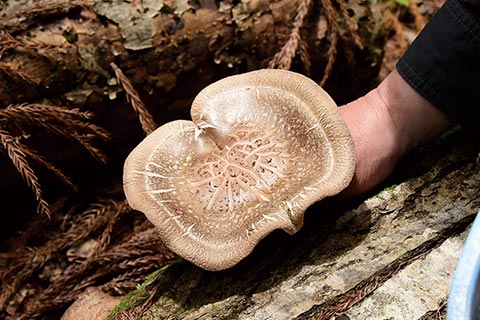
Kinoko Haraki, grown in a natural environment, is very large, and the shiitake is as good as an adult's hand. Many people are surprised at the size, solid texture, and flavor that they have never seen before.
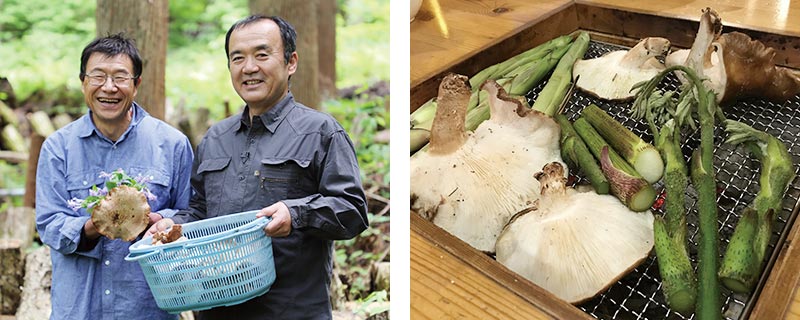
A specialty of "Marunaka Rodge" is a kidnako dish that you can enjoy with extremely simple cooking, making use of the taste of the ingredients. "Konokoya and wild vegetables, which are rich in minerals and black soil moistened by melting water, have different flavors and flavors," said Kadowaki (right photo). He has a deep friendship with Masakazu Kitazawa (left photo) of the "craftsman hall", saying, "Not only wild vegetables, but also natural herbs like Kuromoji, and the sap of white karaba that contain plenty of the blessings of the earth, the mountain is a treasure trove of valuable ingredients. Mr. Kadowaki's mushroom is one of the treasures, "says Kitazawa.
[Marunaka Lodge]
4424-2 Toyogo, Nozawa Onsen Village, Shimotakai-gun TEL 0269-85-2157
"Mushroom is a wooden child"
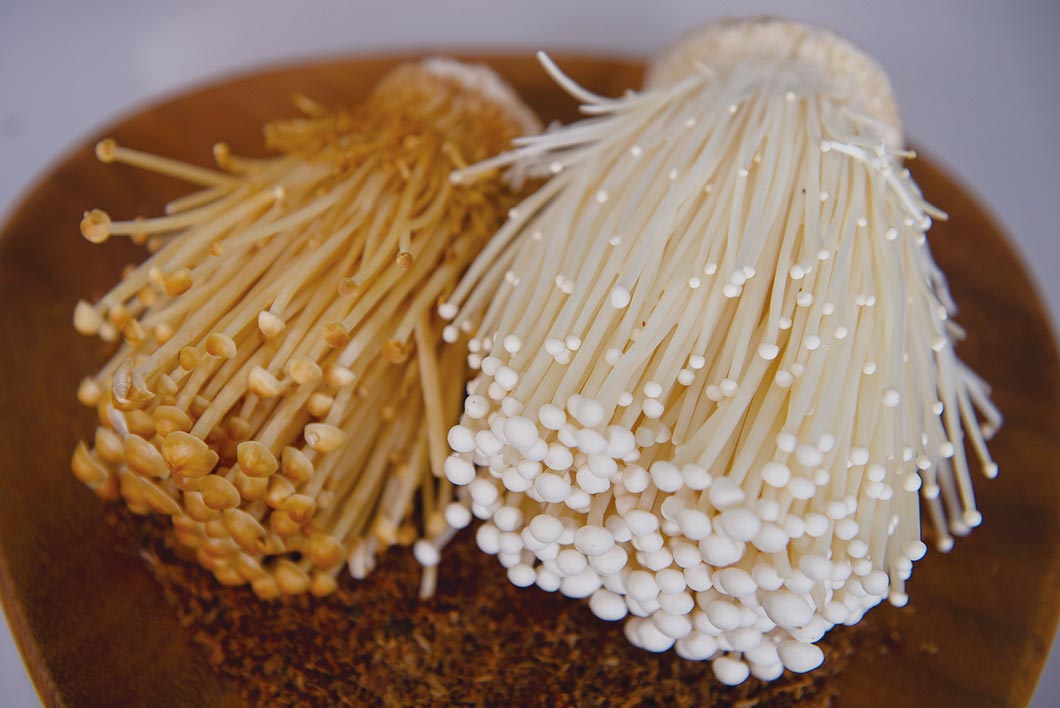
Margin Co., Ltd.(Nagano City)
Enokitake is an enokitake where Nagano Prefecture accounts for more than 60 % of the nationwide distribution volume. In the past, a medium that uses oga powder (wooden powder) (bacteria beds that grow mushrooms) were used, but in recent years, the mainstream is the land that breaks the inexpensive foreign -produced corn kob (core of corn) that can greatly increase yield. is. Meanwhile, Nagano City's "Marukin" is still crushing domestic materials and making a medium that has been aged for 1-2 years. While many producers change their cultivation methods in search of low price and efficiency, the company has the mission to contribute to the health and happiness of people and the earth through Enokitake. , We continue to make the other ways.
"As mushrooms are called" Kinoko ", in nature, they grow from forest stumps and fallen trees, and they cannot be photosynthetic, so they grow up. In pursuit of the original environment and taste that grows, we continue to grow old -fashioned. "
This is the managing director Keisuke Kaneko. The kitake mushrooms, which include the blessings of the forest, have a sweet fragrance, the stems are thick, solid, you can enjoy a crunchy texture, and have a rich flavor. The broth is also yellowed, which uses corn cob, but the company is clear, so the dishes do not disturb the color of other ingredients. And since the ingredients used are made by using the thinned wood of domestic wood, and the raw materials used are clear, in addition to Michelin -stars with a focus on safety and security, luxury inns, and natural food restaurants for Vegan. It is also used in ingredients.
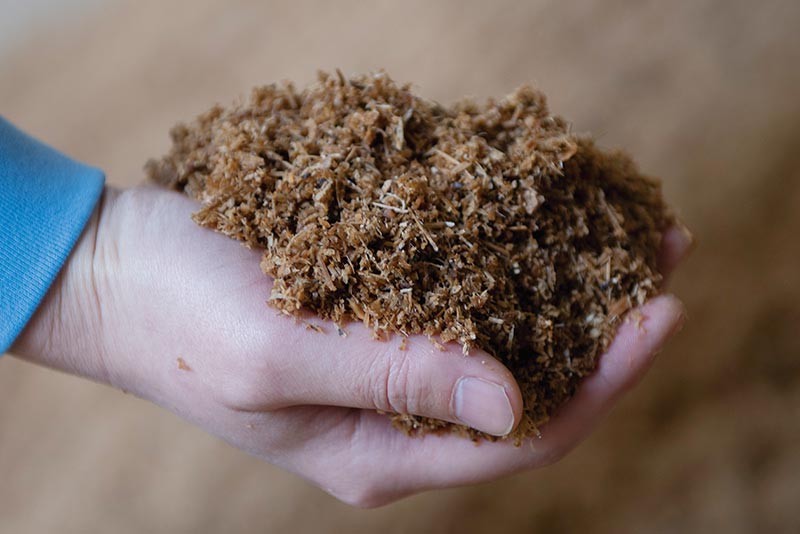
In addition, the cultivation room is set to the same temperature, humidity, and brightness similar to the harsh natural environment, aiming for an environment in which natural chicken grows. The prepared water is also made of natural spring water in Togakushi, Nagano City.
Furthermore, the medium after the enkitake harvest is 100 % effective. Mushroom bacteria are actively active after harvesting due to wood -derived medium, and when it is aged for about a year and then scattered in the field, the hyphagus remaining in the medium breaks down the organic matter and brings out the power of soil. It seems that there is a reference from a farmer with organic pesticide -free vegetables. The soil was also donated to the apple farmers affected by the East Japan Typhoon in the first year. With these initiatives, he won the Grand Prize in the “Happy Shinshu Section” on the theme of “Health and Longevity / Security” of Shinshu Brand Award 2019. The company's recognition is beyond the food industry and has expanded as a sustainable business model.
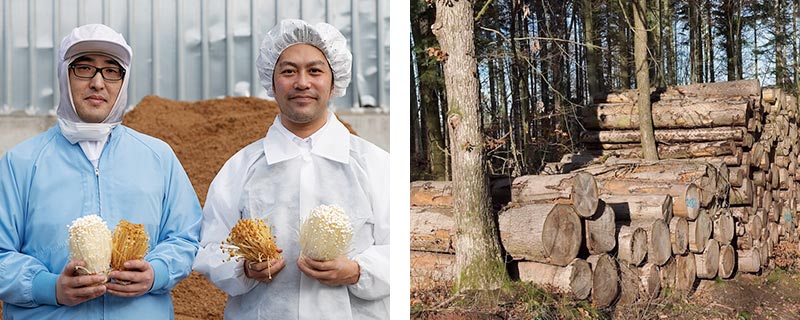
The domestic wood used for the medium is thinned wood about 30 years old. "We use thinned wood to create and grow forests to create the soil soil to deliver the special blessings of the forest to many people in the town." And Kaneko (right photo).
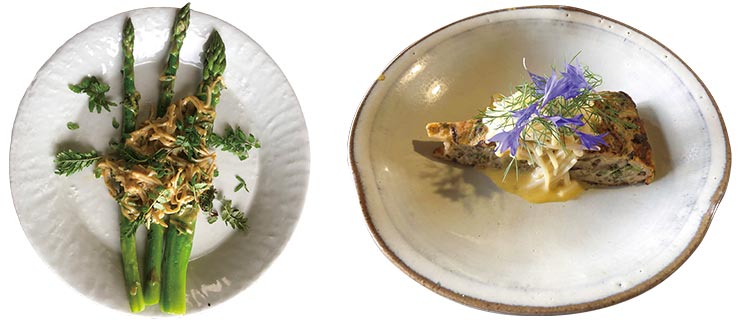
"Enokitake tends to imagine hot pot dishes, but in order to tell you that it fits various dishes regardless of the season or genre, we will introduce various kinds of kitake mushrooms on our website in the future." Kaneko.
The photo shows the Spanish omelet and asparagine egg yolk sauce (written by Masakazu Kitazawa)
[Margin Co., Ltd.]
2367-1 Shinonoi Komatsubara, Nagano City TEL 026-293-2177
https://www.marukin.jp/
INFORMATION
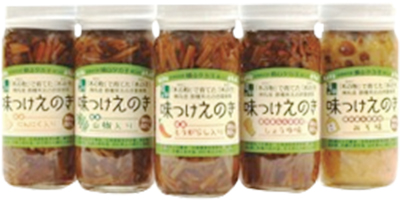
Ginza NAGANO Partially on sale
In addition to the mainstay pure white species Enokitake, it is also cultivated by a brown -based Enokitake mushroom that is closer to the natural state. Ginza NAGANO Product development supervised by Takako Yokoyama, who is familiar with the event lecturer
It's like hors d'oeuvre! Rare of the rare custody of our company integrated production
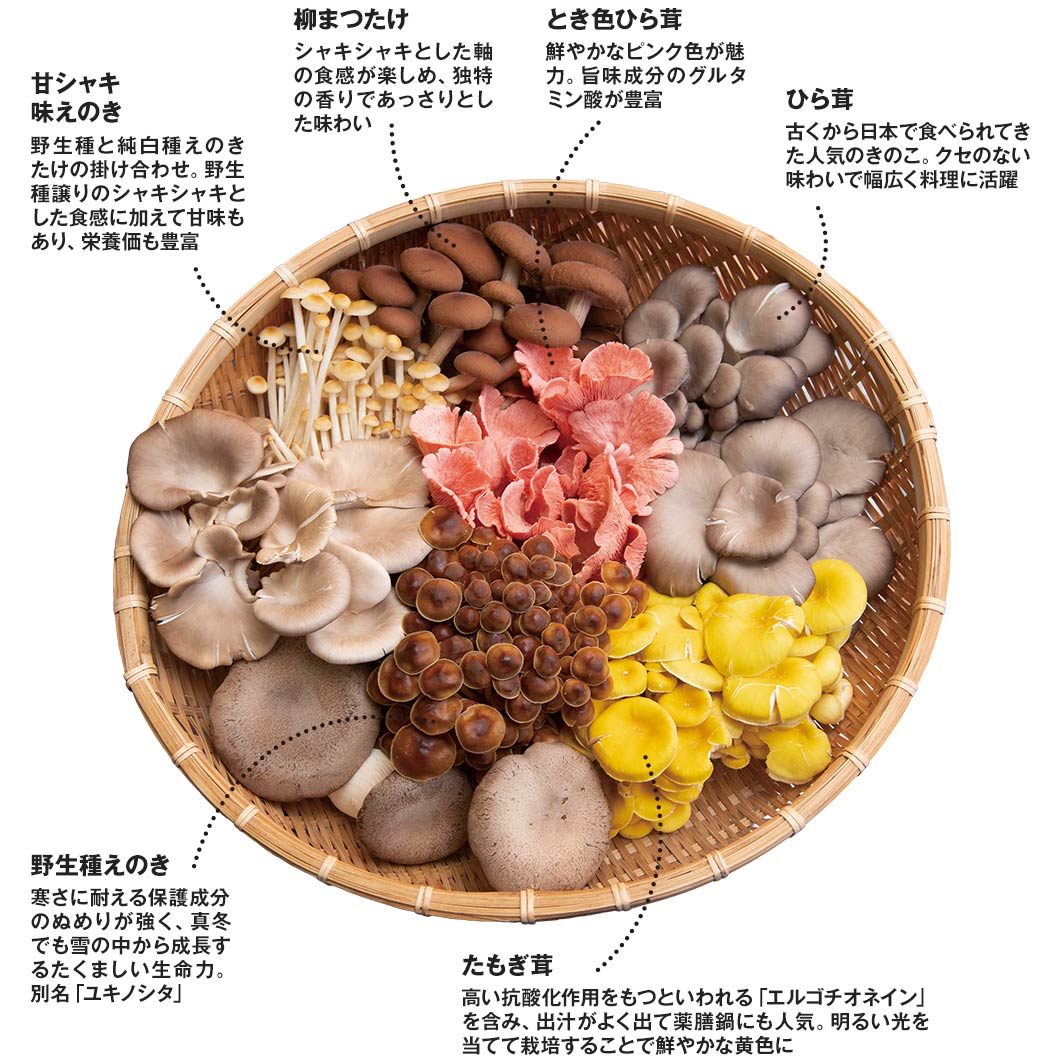
Mushroom village(Suzaka City)
"Mushroom Village" is located at the foot of Sugadaira Kogen, where a factory is set up in a rich mountain village. We work on ourselves from the development of seeds to cultivation and processing.
"You can stick to the specifications of detailed cultivation because you do the bacteria nurturing in -house," said Masahiro Arai, the Mushroom Village Division of the Nobuko Kogyo Co., Ltd. Originally, the company was undertaking the design and construction of the plant (a set of factory facilities) for the mushroom farmers, and took advantage of the know -how and entered mushroom cultivation more than 30 years ago. Currently, we are cultivating a variety of mushrooms that are difficult to produce mass -produced and are rare.
There are six types of cultivation: "Tamogi mushrooms", "sweet shaved taste", "wild species green", "Toki -colored mushrooms", "Hira mushrooms", and "Yanagi Matsatake". "Tamogi mushrooms", "Toki -colored spin mushrooms", and "spinning mushrooms" are growing from early summer to autumn, while Enokitake mushrooms are mushrooms that grow from autumn to winter. The temperature, humidity, light, etc. of the cultivation room are changed according to each, and the cultivation environment is prepared, and some facilities such as the bactericidal kettle in the medium are manufactured in -house. The mushrooms made in this way are all rich in umami and nutritional value. In addition, "wild species ekenki" is a cultivation of the original species of Enokitake mushrooms that were native to the mountains. We have created new varieties, such as crossing a general pure white species Enokitake to create a "sweet sashimi -flavored sea".
"Toki -colored mushrooms" are difficult to manage while cultivating them. It is a native species that grows naturally in Noyama in Japan from early summer to autumn, but it is delicate and easy to wither, and only 4 to 5 farmers in Japan are available. The attraction is the beauty of pink shades, and is used in dishes that add color regardless of Japanese and Western dishes, and is often used in wedding dishes.
"I received the seed bacteria from producers outside the prefecture who had stopped cultivation, but I immediately understood why other companies stopped in a series of difficulties. Because of their different individuality, there are some places that are not yet known, and there are always new discoveries in cultivation every year. "
It takes time and passion, and there are many producers in Japan that handle so many rare species. That's why it is highly evaluated by the chef. Continuing to grow six kinds of mushrooms without waste is not a muscular. Nevertheless, the enthusiasm of "I have to make it for the chefs who want me" is the driving force of Arai.
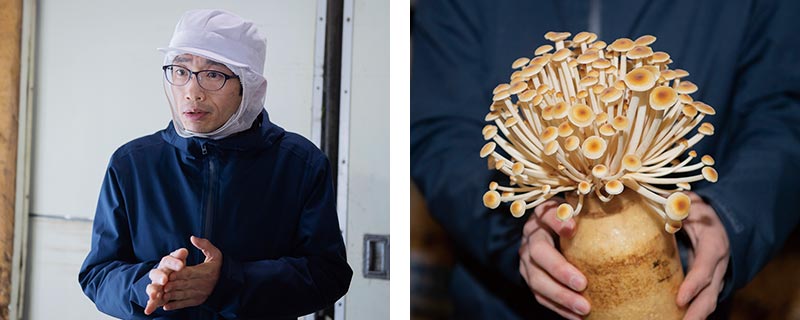
"If you think about the taste and health of the eater, it is best to grow your mushrooms without stress. For that reason, we grow mushrooms so that they want to grow up," says Arai. We do not do a common paper roll (to wrap the bottle in a paper so that it stretches straight so that it stretches straight).
[Mushroom village (Nobuko Kogyo Co., Ltd.)]
1883 Nobe, Suzaka City TEL 026-246-5888
http://www.kinokomura-dayori.com/shop/
INFORMATION
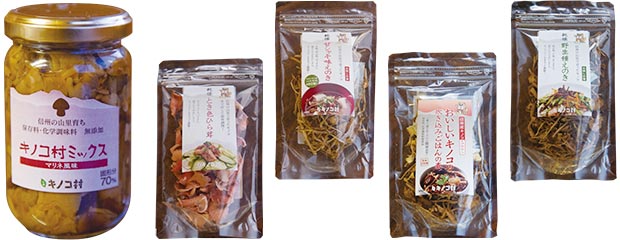
Various processed products Ginza NAGANO On sale at!
Immediately process in a fresh state, and become a product without impairing taste and nutrition. Soak in the water that can be soaked in water that can be soaked in various dry mushrooms, return softly, use it for cooking, and use it as a dish, and "dry sweet sali -flavored flavor" and "dried wild species" are not required. In addition, "Dry Sweet Shaki Shark Relax" can be cooked once in a frying pan, and you can taste it even if you eat it once and eat it like a snack.
Successful cultivation of "phantom kimoko"! Coprine spread out of Nagano
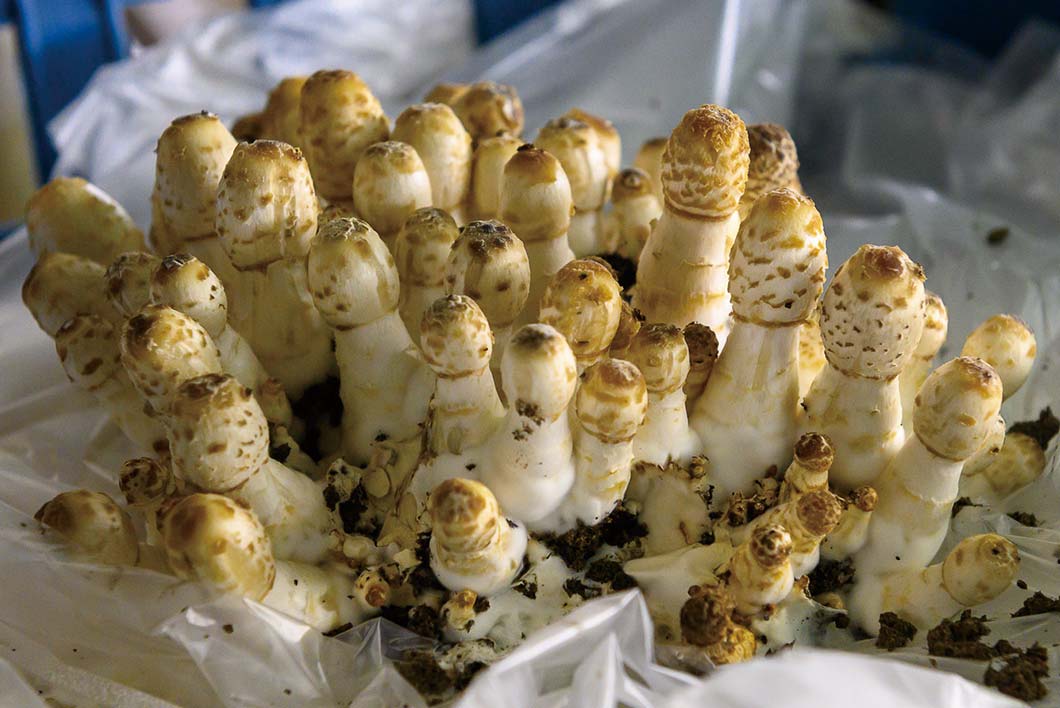
Agricultural Association Corporation Shimada(Nagano City)
"Copleine" is a luxury in Europe. It is a beautiful white and beautiful mushroom like a tsukushi, has a unique and unique texture, has a strong taste, and has no habit that suits any dish. It is distributed almost all over the world, and it grows naturally in grasslands and fields from spring to autumn, but it is difficult to grow. This is because, as the name of the Japanese name "Sasakreecht Yotake", it does not last long after growing. For this reason, it is said to be "phantom kokinoko", and it is said that there are few cultivation examples nationwide, and no one has succeeded in continuous production so far. Meanwhile, Hideaki Shimada, the second generation of the agricultural union corporation in Nagano City, who has been studying for about 25 years, succeeded in cultivation in 2016. It is a valuable producer who continues to grow.
"I was growing mainly mushrooms that grow in trees and forests, such as Hiratake and Bunning Meju from the predecessor, but the cultivation method was different because it was generated from the soil, and there are no precedent producers in the first place, so the cultivation theory is the cultivation theory. I didn't know anything at all, and I wanted to stop it many times.
At one point, it was finally annihilated. Nevertheless, we recreated from the seeds by tissue culture, and thoroughly reviewed the cultivation method. The nutrient of the medium was changed, and the culture was performed in a bottle, but then the medium was spread like a ground, so that it grows in a form close to nature. The cultivation rooms are also artificially created day and night temperature differences by managing each unit, promoting growth. After harvesting, vacuum wrapping prevents growth and deterioration by oxygen, and ships with a beautiful shape. In this way, it is now known as a specialty store that meets the special needs of specialty stores, and some restaurants say that they cannot do business without Coprine.
"However, the awareness is not yet high, so it would be nice if you could know from this unusual existence, which looks and texture and has a good taste."
No matter how difficult it is, Mr. Shimada, who sincerely faced Coprine without giving up and opened the manual road. I will keep an eye on this rare development that is not on the market.
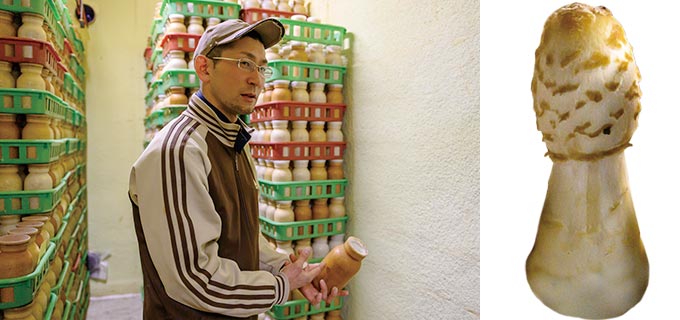
Mr. Shimada, who took over cultivation from the predecessor and succeeded in commercialization through twists and turns. Mr. Shimada was named from the scientific name "Coprinus Comatus".
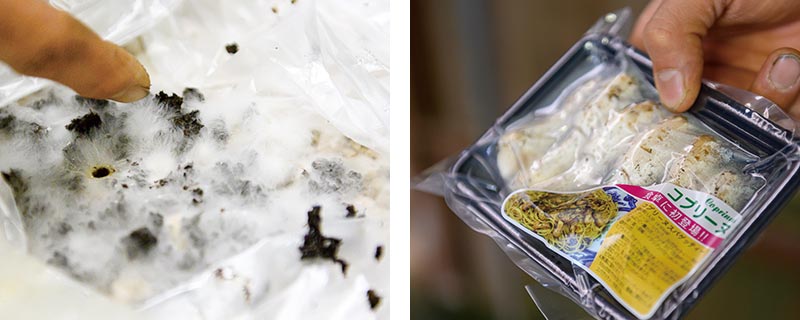
When the hyphagitics are widespread in the bottle, the medium is expanded and cultivated. If the choprine grows to about 12 to 25 cm, the umbrella has a fluffy texture, the axis is crunchy, and the root is crunchy, but in this state, the preservability is low, so the size of the small finger is as large as the small finger. It is harvested and commercialized.
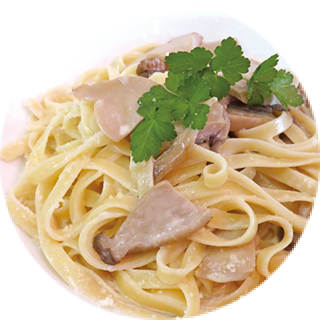
How to eat Coprine
The choprine harvested in a young state has a hard and strong fiber, so you can enjoy a crunchy texture and resemble a mushroom, but you can feel the depth and richness. As with mushrooms, the cooking method is recommended for a stewed dish with a strong taste. It goes well with tomato stewed, rich cream, stew, curry, etc. At restaurants, it is sometimes offered as an exquisite mushroom pasta. In the case of Japanese food, it is recommended to cook so that the taste of the ingredients is soaked, such as cooked rice.
[Agricultural Association Corporation Shimada]
171 Otsuka, Aokishima-cho, Nagano City TEL 026-286-2766
INFORMATION
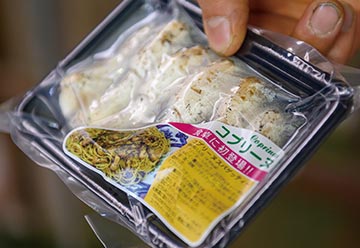
Ginza NAGANO Has been handled for a limited time
This article is information as of July 2020.
Please note that products handled are subject to change.















